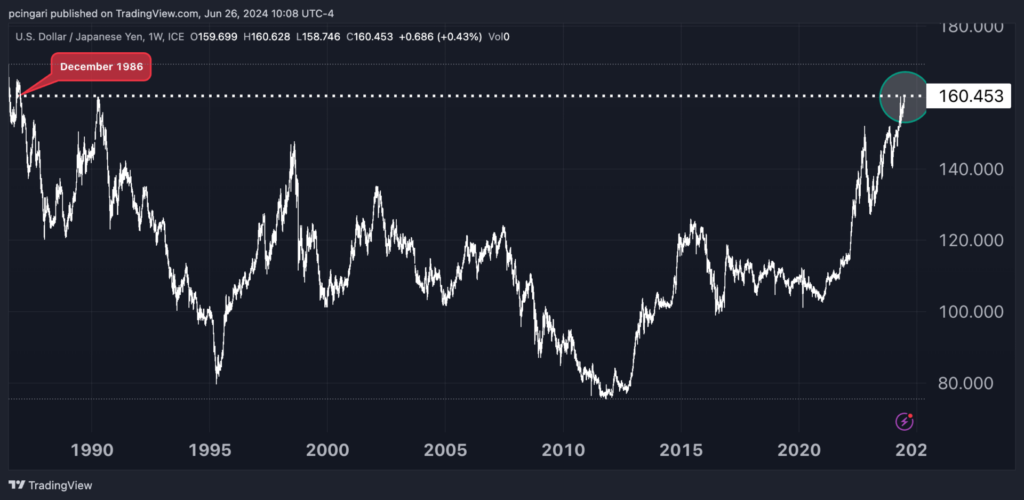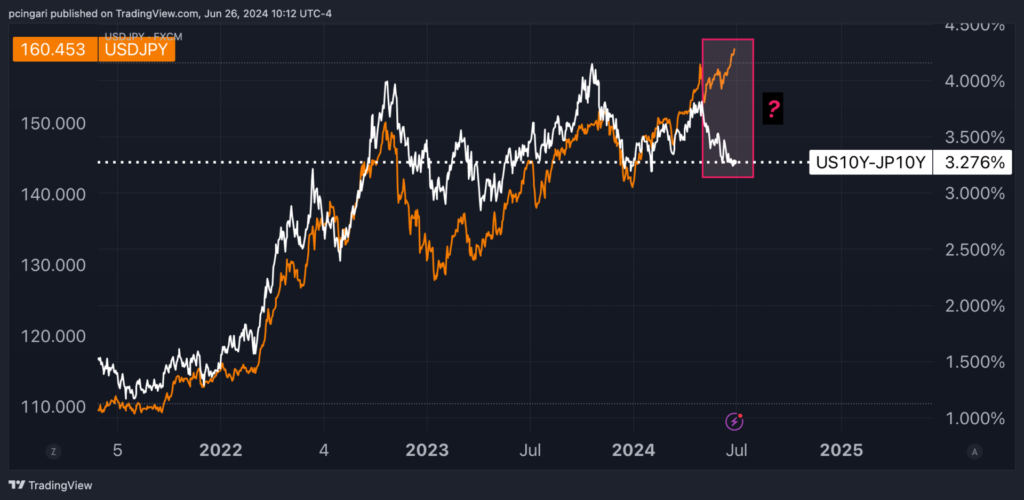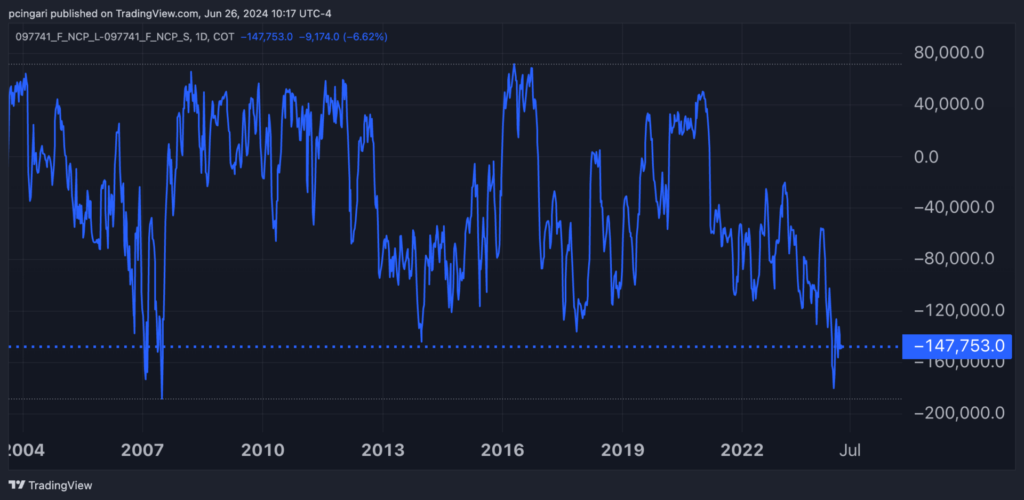Zinger Key Points
- Japanese yen fell past 160 per dollar, surpassing April 2024 peak, and hitting December 1987 levels.
- Japan spent $61.3 billion on currency intervention from late April to late May, involving likely two interventions.
- Get real-time earnings alerts before the market moves and access expert analysis that uncovers hidden opportunities in the post-earnings chaos.
The Japanese yen tumbled past 160 per dollar on Wednesday, surpassing its late April 2024 low that previously prompted sharp interventions from the Bank of Japan, which sold forex reserves to curb the yen’s volatility.
The yen, as tracked by the Invesco CurrencyShares Japanese Yen Trust FXY, has now fallen to its lowest level since December 1987 against the greenback, depreciating by a third of its value over the past three years, amid a persistent divergence in interest rates between the Bank of Japan and other major central banks, particularly the Fed.
At its June meeting, the Bank of Japan unanimously kept its key short-term interest rate at approximately 0% to 0.1%, as anticipated, following its first rate hike since 2007 and the conclusion of eight years of negative rates in March.
Moreover, the board suggested it might consider reducing its JPY 6 trillion per month bond purchases at its July meeting.
Japan spent $61.3 billion on currency intervention from late April to late May, a period likely involving two separate instances of intervention.
Last week, the U.S. Treasury Department added Japan to a foreign exchange “monitoring list,” a decision not attributed to Japan's interventions in April-May to support the yen but for meeting two of the three mechanical criteria for the list.
This chart shows a higher dollar-yen exchange rate, indicating the dollar strengthening against the yen.

Analyst Reactions
“The JPY will probably continue to attack recent lows ahead of the release of monthly data, including Tokyo's CPI and industrial production figures on Friday,” wrote BBVA chief strategist Alejandro Cuadrado.
“The USD/JPY remains high, but without shocks. We confirm our idea that BoJ’s warnings about possible interventions are still in the air,” said Banca IMI’s market strategist Luca Cigognini.
"The Japanese authorities will wait at least for PCE on Friday to decide on intervention, even if the price breaks through 160 before that," said Takafumi Onodera, head of sales and trading at Mitsubishi UFJ Trust & Banking Corp. in New York.
“The decision now depends on two variables — the speed of yen depreciation as well as the level — rather than one," Citigroup Inc. analysts led by Osamu Takashima wrote in a note.
Something Has Broken Out…
A notable development has been the recent decoupling of the USD/JPY exchange rate from the 10-year yield spread between Treasury and Japanese government bonds.
Until May 2024, this correlation held almost perfectly, as a widening yield spread forced upward pressure on the dollar-yen exchange rate and vice versa.
However, over the past two months, the tighter 10-year yield spread between the U.S. and Japan hasn’t led to a drop in the dollar-yen exchange rate, as yen depreciation continued.
Why is this golden rule for trading the USD/JPY pair is no longer holding?

‘A Cautionary Tale About The Consequences Of Allowing Debt To Grow Unchecked’
Possibly, traders are currently testing the Bank of Japan’s resilience, knowing it cannot raise rates significantly and that continued interventions by selling reserves are unsustainable in the long term.
According to Robin Brooks, senior fellow in the Global Economy and Development program at the Brookings Institution, “Yen weakness stems from Japan's very high debt, which forces the bank to cap long-term government bond yields via open-ended bond buying.”
“Japan serves as a cautionary tale about the consequences of unchecked debt growth,” the economist added.
Japan is no longer the low inflation outlier it once was, as its core inflation hit the 2%. The inflationary impulse from the recent yen depreciation may now be less welcome.
Brooks stated, “Countries can use their central banks to cap government bond yields, but that just transfers weak debt dynamics into currency depreciation.”
Recently, Japan's Ministry of Finance has intervened repeatedly to halt the yen’s decline, with interventions on a much larger scale than those seen in September and October 2022.
However, these efforts have had limited impact because the Bank of Japan’s purchases of government bonds—necessary to maintain the yield cap—indirectly weaken the yen, counteracting the Ministry of Finance’s attempts to support it.
This situation effectively cancels out the efforts of both institutions, highlighting the divided stance on yen depreciation within Japan.
“Given this divided policy message, speculative yen shorts, according to CFTC positioning data, have not pulled back materially,” Brooks stated.
As the chart below indicates, the net non-commercial positions on the yen currently stand at a short of 147,753 contracts, a figure significantly below the historical average.

Read Next:
Image generated using artificial intelligence via Midjourney.
© 2025 Benzinga.com. Benzinga does not provide investment advice. All rights reserved.
Trade confidently with insights and alerts from analyst ratings, free reports and breaking news that affects the stocks you care about.